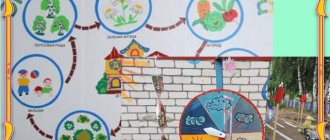MAGAZINE Preschooler.RF
Creative project “Tales of A.S. Pushkin"Municipal state preschool educational institution of the city of Novosibirsk “Kindergarten No. 398 “Swallow” of a combined type”
Teacher of the 1st category: Sysenko T.I.
- Scenario for literary gatherings . ”
- Consultation for parents “Parenting with a fairy tale” .
- Photo vernissage.
PROJECT INFORMATION CARD.
Project type:
— according to the composition of participants: group (children, parents, teacher, colleagues).
- according to the target setting: educational - creative, project participants get acquainted with the literary and fairy-tale heritage of A. S. Pushkin (collect a library, video library, organize an exhibition of children's works, participate in literary gatherings)
Project participants:
- Educators, specialists.
- Children of the senior group in the amount of 20 people.
- Parents.
Venue of preschool educational institution No. 398 “Swallow” , Novosibirsk
Organization of activities of project participants: interaction and cooperation of all project participants
Implementation period: From 12.05.12017 until 06.06.2021 (medium term)
RELEVANCE.
The fairy tale is a lie and there is a hint in it!
A lesson to good fellows.
A. S. Pushkin.
This project was developed for children of the older group, on the eve of the anniversary of the great Russian poet A.S. Pushkin.
Two centuries have passed since Sasha Pushkin heard the old fairy tale about envious sisters and a greedy old woman, but it still captivates the reader with its wonderful fiction and good feelings.
It is easy to imagine the joy of a person who picks up a book of beautiful poetic fairy tales. The impression from such a meeting is unforgettable - so great is the emotional impact of the poetic performance that the great Russian poet A. S. Pushkin unfolds before the reader’s eyes, on the pages of the book. His wonderful gift of telling believably about the most incredible events captivates the reader, forcing him to empathize with the characters, rejoice and grieve with them.
Opening a book, the little reader is as if opening a magical casket with jewels - these poetic lines shining with all colors are so beautiful, so festively elegant. The poet’s fairy-tale world is deeply individual and at the same time in no way diverges from the Russian fairy-tale world. Pushkin drew his multi-colored fairy-tale pattern based on the folk canvas. As in other areas of literature, A.S. Pushkin became the discoverer of new paths in fairy tales. It was he who, by giving classical images of the genre, determined the appearance of the fairy tale, its laws, and showed the measure of the relationship between folk sources and the streams and rivers of written fairy tales that flowed from them. The tales of the great Russian poet are not forgotten throughout his entire life. They are marked by high meaning and poetic skill, making you remember the best moments of the surrounding reality: goodness, beauty, love of life.
PROBLEM:
After reading one of the most beautiful works by A. Pushkin, “The Tale of Tsar Saltan, his son, the glorious and mighty hero Prince Gvidon Saltanovich, and the beautiful Swan Princess,” questions started pouring in from the children: “Who is A. S. Pushkin?” , “Where and when did he live?” , “What other fairy tales does he have?”
The parents also showed interest in the work of the great poet. They asked teachers to help fill the vacuum in the literary reading of A. Pushkin’s works.
PROJECT OBJECTIVES:
- Introducing children to Russian classical literature through acquaintance with the works of A.S. Pushkin
- Development of aesthetic and cognitive aspirations of children of senior preschool age through the best examples of Russian art
— Development of creative abilities in artistic, speech, musical, artistic and productive activities of children and adults.
TASKS:
1. Introduce children to the works of Alexander Sergeevich Pushkin,
his fairy tales for children.
To promote the development of the ability to listen to fairy tales with interest, comprehend what they hear, and memorize excerpts of fairy tales and poems.
2. Develop family reading traditions; to form the interest and desire of children to reflect their impressions in visual and musical activities.
3. Create an atmosphere of emotional comfort, mutual understanding and support; develop communication skills and the ability to communicate with adults and peers in different situations.
EXPECTED RESULTS:
Children have developed an interest in fiction through familiarity with new books - fairy tales by A. S. Pushkin. They listen and watch fairy tales and poems by A.S. Pushkin attentively and with interest. in kindergarten and at home with parents. They read poems and excerpts from fairy tales expressively, with natural intonations. They participate in reading the text and acting out scenes based on familiar fairy tales, using dolls, costume elements, and decorations, and enjoy performing in front of peers, parents, and other guests. Children are familiar with the concept of “folk art” , “folk crafts” .
PROJECT IMPLEMENTATION STAGES:
Stage I - preparatory:
- conversation with parents about the relevance of family reading with children;
- theoretical research on this problem;
- goal setting, development of a project implementation plan; determining how results will be presented.
Stage II - formative (practical)
- replenishment of the development environment (collection of information, material, production of folk costumes and its elements, replenishment of the music and film library);
- acquaintance with various forms of folklore, familiarization with the traditions of folk art;
- mastering the characteristic movements of folk dance;
- learning the Russian folk outdoor game “Golden Gate” ;
- equipping the local history mini-museum “Russian Izba” ;
- organizing and conducting literary gatherings with preschoolers;
- inclusion and interaction with teachers and parents.
Stage III - Final, presentation of the project.
- literary gatherings with preschoolers “There are miracles, there are fairy tales” ;
- exhibition of handicrafts for children and adults;
- exhibition of books based on the works of A.S. Pushkin.
WITH CHILDREN, TEACHERS, PARENTS.
PROJECT RESULTS.
The following people took part in the implementation of the project: children of the senior group and their parents, kindergarten staff.
The following results were obtained: all the fairy tales of the great poet were read with delight. The pupils and their parents got acquainted with the life history and work of the great compatriot. The desire to continue reading other works of A. Pushkin has increased - not only fairy tales, but also poetry. Attributes and costumes for theatrical activities were made. The group has organized a library and video library of cartoons, poems and fairy tales by A. S. Pushkin, which is constantly updated. Children's understanding of folk art, folklore, and music has expanded. The result of all the work on the project can be considered the holding of literary gatherings “There, miracles, there is a fairy tale wandering.
CONCLUSIONS.
The results of our work showed that fairy tales occupy an important place in a child’s life. We managed to interest not only children, but also their parents in the fairy-tale life. The fairy tale returned to the house, to the family, to life. We hope that the educational, ideological, moral, and cultural priorities laid down by fairy tales in preschool childhood will determine the life path of preschoolers and influence the development and state of the entire civilization.
LITERATURE.
- Davydova O.I., Mayer A.A. Bogoslavets L.G. Projects in working with families. M. Sfera, 2012.
- Parfenova E. V. Development of children's speech in theatrical activities. M.: Sfera, 2013.
- Derkunskaya V. A., Oshkina A. A. Game educational activities of preschoolers. M.: Center for Pedagogical Education, 2013.
- Bogatyreva Yu., Bogatyrev A. Preschoolers about Pushkin. Gnome and D, 1999
- Ushakova O. S., Arushanova A. G. Classes on speech development in kindergarten. M., 1998.
- Tales of Pushkin. New format. 2003.
- Fairy tales of Russian writers. Children's book. 1985.
VIDEO LIBRARY.
Soyuzmultfilm 1950 “Collection of cartoons based on fairy tales by A.S. Pushkin"
| Next > |
General morality
Whatever fairy tale the child chooses to write, the conclusion from it can be general. If in class you are given the task of making notes on several stories, students will see that the theme of good and evil in Pushkin’s works is expressed very clearly. Positive heroes with such qualities as wisdom, justice, goodwill, always prevail over those whose characteristics include greed, anger or envy.
That's why children love Pushkin's fairy tales. The works that he composed are attractive because they give clear guidelines on how to act so that everything turns out well in life, and make you think about the consequences of bad actions.
The story of Tsar Saltan
“The Tale of Tsar Saltan” is the title of my favorite work by Pushkin. It begins with a conversation between three girls, each of whom shares dreams of how she would behave as a ruler. The king accidentally overhears the conversation and decides to marry the younger girl, who wanted to give birth to a son-hero, and makes her sisters a weaver and a cook in accordance with their desires.
However, the sisters are unhappy and slander the more successful girl. This leads to the queen, along with her newborn son, being locked in a barrel thrown into the open sea. However, the magical child grows very quickly and soon frees himself and his mother. Next, he meets the Swan Princess and frees her from the Kite, for which he receives an entire kingdom as gratitude.
The reign of Tsarevich Guidon is fair and kind. After a while, he finds his lost father, and the family is reunited.
Thus, the storyteller talks about how important it is to be kind, brave and decisive and not to despair in any situation. The envy and lies of other people can bring a lot of suffering, but we must remember that with the help of love and forgiveness all difficulties can be overcome. However, even the kindest, wisest and most honest people, like Tsar Saltan, can make mistakes and be too gullible, so decisions must be made, remembering that not all people tell the truth.
About the priest and worker Balda
My favorite fairy tale by Pushkin is dedicated to the story of the cunning worker Balda, who ended up in the house of a greedy priest. The work begins with the classic fairy tale introduction “Once upon a time...”. Next we talk about how the “pop, with a thick forehead” hired Balda at the bazaar. What attracted him to the employee was the low cost of the services offered. For his work for a year, the peasant only asked permission to give the owner three slaps on the forehead .
The deal took place, and Balda began to work. He performed his duties diligently, but when the year began to come to an end, the priest decided to avoid even such an inexpensive payment for him and gave the man a supposedly impossible task. However, Balda dealt with him, although to do this he had to trick the devils into obtaining rent.
The priest had no choice but to pay the worker, but he made such noise that it knocked the owner out of his wits. From this book you can get the idea that greed and the desire to deceive another will never lead to anything good, and cunning and intelligence will always help you find a way out of any situation.
About the fisherman and the fish
My favorite hero of Pushkin's fairy tales is the Golden Fish. A corresponding story is told about this magical animal, which can fulfill any desire. In it, the main character uses her ability to save her own life. Caught in a net, she offers the fisherman his wish in exchange for freedom. But the kind old man lets her go just like that.
However, the story does not end there. The fisherman's wife, having learned about what happened, forces the old man to look for the magical creature again to ask for a new trough. When the wish is fulfilled, the woman becomes greedy and asks for more and more gifts.
The old woman, who knows no limits, soon logically returns to her original poverty. This shows that excessive authority and rudeness, the desire to do nothing and live in luxury will never lead to anything good. You need to be content with what you have and set yourself real goals, otherwise you can instantly lose all the benefits.
In this situation, the only pity is the old man, who meekly indulged the desires of his wife, although in his soul he opposed them, he was ashamed of his requests . But he is humble and wants nothing for himself, continuing to live in poverty even when his wife becomes rich.
About the dead princess and the seven heroes
Most of all among Pushkin's fairy tales, I like the story in which the queen, confident that she alone should be the most beautiful in the world, tries to get rid of her stepdaughter, who could act as her rival. The cruel woman orders the maid to leave the girl tied to a tree in the forest so that the wolves can kill her, but she does not dare to do such an act and lets the beauty go.
The girl seeks shelter in the forest and finds a house where seven heroes live. The men take pity on the poor girl and accept her as a sister, but soon the queen finds out that her plan failed and decides to put it into practice again.
This time she takes the form of an old woman and treats her stepdaughter to a poisoned apple, which puts her into a deep sleep. The heroes who find the girl cannot wake her up and sadly leave her in a crystal coffin in a cave.
The beauty is saved by the prince, whose power of love awakens the unfortunate woman. The young couple gets married, and the evil queen dies from her own anger and powerlessness.
This fairy tale in Pushkin’s work can be considered an example of how evil and envy towards others can destroy many lives. But it also gives faith that loyalty and virtue will overcome any troubles.
The Tale of the Golden Cockerel
The tale of the Golden Cockerel is one of the most unusual, because its main character is a negative character . This is King Dadon, who is so accustomed to his power that he considers it possible to do whatever he wants. When he was young, he barbarously attacked his neighbors' property, but as he grew older, it became increasingly difficult for him to defend himself against retaliatory attacks.
The situation is fair, because he could have made peace earlier and lived out his life in peace, but in the current situation something needs to be done, and Dadon came up with the idea of turning to an astrologer for help. The king and the sage came to an agreement, according to which the former receives the golden cockerel that guards the state, but undertakes to fulfill any desire of the elder.
At first everything was fine, but then the astrologer demanded retribution in the person of the Shamakhan queen, and Dadon, who did not intend to adhere to the oath, simply killed the benefactor. However, the unworthy and unfair act was immediately punished. The magic cockerel pecked the king on the head, causing him to die immediately.
Thus, the cockerel acted as a higher power creating justice, and the reader understood that any promise must be fulfilled, otherwise punishment will follow.




